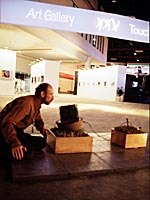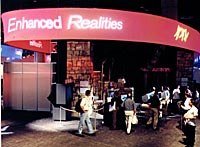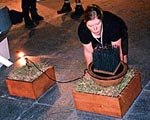Elaine Brechin's "Windgrass." Courtesy of Elaine Brechin, © Interval Research.Growing up as a self taught artist, I had to read many "how to" books to learn new drawing and painting techniques, so 25 years ago I had no idea there were artists using computers to create artwork. Thanks to my parents, who took me to the library religiously, I started reading more and more science and technology-related books and magazines. This was my introduction to computers and computer art, and it fascinated me. I didn't actually have any hands-on experience with computers until the early '80s, and the desire...

Growing up as a self taught artist, I had to read many "how to" books to learn new drawing and painting techniques, so 25 years ago I had no idea there were artists using computers to create artwork. Thanks to my parents, who took me to the library religiously, I started reading more and more science and technology-related books and magazines. This was my introduction to computers and computer art, and it fascinated me. I didn't actually have any hands-on experience with computers until the early '80s, and the desire to create my own artwork on a computer has driven me to where I am today.
After reading about the annual SIGGRAPH conferences roughly 15 to 20 years ago, I knew that some day I would have the opportunity to visit one. My dream has come true and I could not have asked for a better first experience than the 25th anniversary!
A Gallery of Pioneers
SIGGRAPH '98 was a milestone for electronic art and celebrated 25 years with a chronicle of pioneers in the field. Works of art from trailblazing artists such as Charles Csuri and David Em were on display. I'd previously only seen their work in books or magazines so it was a thrill to see them up close. "Transjovian Pipeline" by David Em was one of the first computer art pieces that really inspired me to get involved. I also had the privilege of meeting Charles Csuri at Ohio State University in the Advanced Computer Art Department while he was giving a lecture on computer artistry innovations in the mid '80s. If interested in learning more about these and other pioneers of electronic art, one can see their artwork and biographies on the SIGGRAPH web site.
At the SIGGRAPH Art Gallery, there were more than 600 works of electronic art, most of which were contemporary works by artists using leading edge technologies. Exhibits varied from traditional digital paintings, drawings, photographs and sculptures to high-tech telepresence projects, interactive installations and web projects. With so much to see and do it's hard to cover it all, but I will relate a few of the more memorable exhibits.

Interactive Play
In the "Digital Pavilions," I tried a Gesture VR interface from Jakub Segen of Bell Laboratories, which allowed me to explore the Yosemite Valley in 3-D, using only my hand gestures to fly through the landscape.
Moving on to the "Enhanced Realities" area, there were many fun demonstrations to see and do, such as "AR2 Hockey" by Toshikazu Oshima, where one can play a game of augmented reality air hockey. Two individuals, donning VR headsets and gloves, play the game in a shared space with a virtual hockey puck!
What looked like a picture-framed video display caught my eye when I suddenly saw myself on the display, warping and morphing much like in the funhouse mirrors at a carnival. As more people gathered the more warping would occur. "Mass Hallucination" by Trevor Darrell of Interval Research Corporation was designed to recognize more than one individual for short periods of time and allow for each individual in a crowd to be distorted separately.

I saw many people dancing at "Shall We Dance?" an exhibit by Kazuyuki Ebihara from ATR Media Integration & Communication Research Lab. Two individuals would dance in separate blue screen rooms and control their dance puppets which were displayed on a large screen for everyone to see. The system was setup to capture not only the individuals' body movements, but faces as well as they controlled their virtual selves in real time. Many people had a laugh or two watching others try to make their puppets dance together.
Something For The Kids
There was also an area just for children called "sigKIDS," which presented a litany of things for kids to see and do. I briefly stopped by the "Generation LEGO" booth since like most kids I loved playing with the colorful building blocks. The new LEGO sets, designed in cooperation with the MIT Media Lab, let children build real functioning robots using LEGO building blocks and robotic components. I sure wish I had those when I was a kid!

Amazing Works
In the "Touchware" art gallery the artwork centered around the sense of touch, so participants were compelled to interact with the artist's work either by being involved in the environment or by hands-on interaction. One of my favorites was the "Stream of Consciousness" by David Small and Tom White from the Media Lab at MIT. In their display was a small running stream of water that flowed over rocks and around a bend into a small pool. Flowing along with the water were projected images of words that one could interact with by touching a water-filled mat that was pressure sensitive. When one pressed on the mat, light would project onto the stream in the shape of whatever pressure was applied, so by applying pressure to the mat one could control the flow of words and even dam them up in the pool. When the letters hit the light that one was producing, they multiplied, scattered and changed color. It was like playing in a creek as a kid again!

Another compelling piece was "Windgrass" by Elaine Brechin. It was fun to watch people bend down and interact with her artwork. What one sees at first is two wooden boxes of grass: one has a post with an electrical cord tied to it running to the other box of grass, which contains a large bowl-like structure with what looks like tall black grass growing out of it, but is in fact, a cluster of tiny incandescent light bulbs. If one bent down to the bowl, it would lean toward them. If one blew across the fiber optic grass, the lights would flow in the direction of the air movement, as would the bowl. It was almost like one was blowing it away from them. This was quite compelling and reminded me of watching a field of golden wheat flowing like water in the breeze.
Even considering how far technology has come in the past 25 years, it still takes an artist and their imagination to produce the kind of works we saw at SIGGRAPH. I look forward to the next 25 years to see how the coming generation of artists will use technology to show us their unique artistic vision.
Chris Lambright is the staff artist for Visual Magic Magazine, a monthly publication focusing on the 3-D graphics and digital effects industries. He can be reached by e-mail at chris@visualmagic.awn.com







